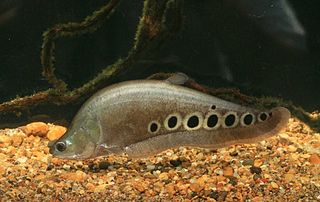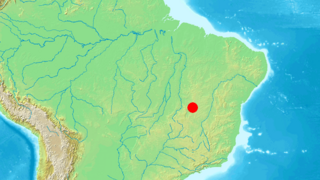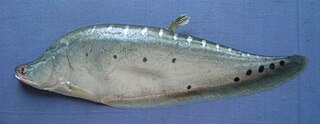
The Gymnotiformes are an order of teleost bony fishes commonly known as Neotropical knifefish or South American knifefish. They have long bodies and swim using undulations of their elongated anal fin. Found almost exclusively in fresh water, these mostly nocturnal fish are capable of producing electric fields to detect prey, for navigation, communication, and, in the case of the electric eel, attack and defense. A few species are familiar to the aquarium trade, such as the black ghost knifefish, the glass knifefish, and the banded knifefish.

An electric fish is any fish that can generate electric fields. Most electric fish are also electroreceptive, meaning that they can sense electric fields. The only exception is the stargazer family (Uranoscopidae). Electric fish, although a small minority of all fishes, include both oceanic and freshwater species, and both cartilaginous and bony fishes.

The black ghost knifefish is a tropical fish belonging to the ghost knifefish family (Apteronotidae). They originate in freshwater habitats in South America where they range from Venezuela to the Paraguay–Paraná River, including the Amazon Basin. They are popular in aquaria. The fish is all black except for two white rings on its tail, and a white blaze on its nose, which can occasionally extend into a stripe down its back. It moves mainly by undulating a long fin on its underside. It will grow to a length of 18"-20". Only a fish for those with large aquariums, minimum 100 gallons.
Knifefish may refer to several knife-shaped fishes:

Glass knifefishes are fishes in the family Sternopygidae in the order Gymnotiformes. Species are also known as rattail knifefishes.

Gymnarchus niloticus – commonly known as the aba, aba aba, frankfish, freshwater rat-tail, poisson-cheval, or African knifefish – is an electric fish, and the only species in the genus Gymnarchus and the family Gymnarchidae within the order Osteoglossiformes. It is found in swamps, lakes and rivers in the Nile, Turkana, Chad, Niger, Volta, Senegal, and Gambia basins.

The clown featherback, also known as the clown knifefish and spotted knifefish, is a nocturnal species of tropical fish with a long, knife-like body. This knifefish is native to freshwater habitats in Cambodia, China, Hong Kong, Laos, Macau, Taiwan, Thailand, and Vietnam, but it has also been introduced to regions outside its native range. It is one of the world's most invasive species.

The royal knifefish or Indochina featherback, Chitala blanci, is a species of ray-finned fish in the family Notopteridae found in the Mekong basin in Cambodia, Laos, Thailand and Vietnam.

Chitala is a genus of fish of the family Notopteridae. This genus contains six species, in which some are important in aquaculture and the aquarium industry. They are commonly known as the Asian knifefishes or featherbacks. They are native to freshwater in South and Southeast Asia.
Stygichthys typhlops, the blind tetra or Brazilian blind characid, is a species of fish in the family Characidae and the only member of the genus Stygichthys. It is endemic to caves in northern Minas Gerais, Brazil. Like other cave-adapted fish, the Brazilian blind characid is blind and lacks pigmentation. It reaches up to about 4.6 cm (1.8 in) in standard length. It is solitary and when kept together in an aquarium, individuals are indifferent to each other.

Eigenmannia vicentespelaea is a species of weakly electric knifefish in the family Sternopygidae. Native to the São Domingos karst area in central Brazil, it is the only known knifefish to exclusively inhabit caves. Measuring up to 21 cm (8.3 in) long, E. vicentespelaea can be distinguished from its relatives by its translucent body and reduced or absent eyes. As some individuals retain well-developed eyes, this fish may have colonized caves only recently in evolutionary time.

The jamming avoidance response is a behavior of some species of weakly electric fish. It occurs when two electric fish with wave discharges meet – if their discharge frequencies are very similar, each fish shifts its discharge frequency to increase the difference between the two. By doing this, both fish prevent jamming of their sense of electroreception.

Chitala chitala is a knifefish from Bangladesh, India, Nepal, and Pakistan, found in the Brahmaputra, Indus, Ganges and Mahanadi River basins. It is sometimes known as the Indian featherback or Indian knifefish. In the past, it frequently included several related Chitala species, but these are now regarded as separate species. The main species confused with this species is C. ornata ; a Southeast Asian species seen regularly in the aquarium trade. The true C. chitala is very rare in the aquarium trade.

The jack-knifefish is a species of marine ray-finned fish belonging to the family Sciaenidae, the drums and croakers. It is native to the western Atlantic Ocean, where its distribution extends along the eastern coasts of the Americas from the Carolinas in the United States to Brazil, including the Caribbean. Other common names include donkey fish and lance-shaped ribbonfish.
Distocyclus is a genus of South American glass knifefishes, with one species in the Amazon basin and another in rivers in French Guiana.

Eigenmannia is a genus of fish in the family Sternopygidae native to tropical and subtropical South America, and Panama. They are typically found in slow-flowing streams, along the edge of large rivers, in deep river channels and in floodplains, and the genus also includes E. vicentespelaea, the only cave-adapted knifefish. Eigenmannia are often found near submerged roots, aquatic plants and floating meadows.

Eigenmannia virescens is a weakly electric freshwater fish found across South America. It is marketed as an aquarium fish.
Distocyclus conirostris is a species of glass knifefishes found in the deep waters of the Amazon basin, lower portions of the Potaro River and in major parts of the Rio Orinoco. They are typically relegated to flood basins, flooded forests and main river channels. They have often been found gathering in small groups around vegetation, indicating a social nature. The fish has semi-translucent, glass-like pectoral and anal fins. The main body is a ground-like color with a lighter head. The largest currently recorded specimen is 34.5 cm.
Eigenmannia cacuria is a species of glass knifefish in the family Sternopygidae. It is found in the upper Parnaíba River of north-eastern Brazil.
Eigenmannia robsoni is a species of glass knifefish in the family Sternopygidae. It is found in the Parnaíba basin of north-eastern Brazil.












